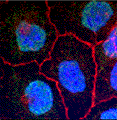Biochemistry, Department of
Document Type
Article
Date of this Version
12-3-2019
Citation
2019 Authors
Abstract
Structural biology has revealed predicting heterologous expression levels, homogeneity, and stability of a protein from its primary structure are exceedingly difficult. Membrane proteins, in particular, present numerous challenges that make obtaining milligram quantities of quality samples problematic. For structural and functional investigation of these molecules, however, this is what is required. Fluorescence size-exclusion chromatography (F-SEC), a technique where a protein of biological interest is fused to green fluorescent protein (GFP) and monitored, circumvents many bottlenecks inherent to membrane protein structural biology. In vivo expression yields, as well as in vitro homogeneity and stability, can be rapidly evaluated utilizing nanogram quantities of unpurified protein. In this chapter we describe our most current protocols for expression screening and biochemical characterization of membrane proteins using F-SEC, as it pertains to a high-throughput (HTP) crystallographic pipeline. Therein, the methods and workflow were designed and optimized for structure–function elucidation of eukaryotic integral membrane proteins, but may be applied to prokaryotic or water-soluble proteins with minor modifications, thus making it a useful general approach.
Included in
Biochemistry Commons, Biotechnology Commons, Other Biochemistry, Biophysics, and Structural Biology Commons



Comments
Methods Mol Biol. 2019 ; 2025: 361–388. doi:10.1007/978-1-4939-9624-7_17